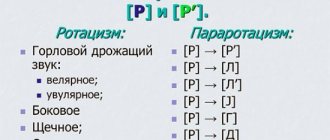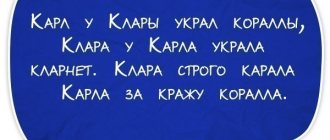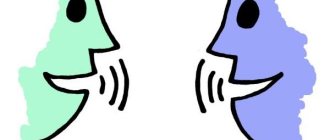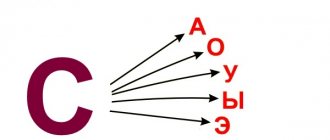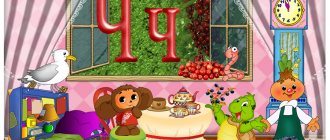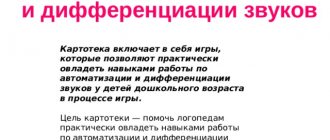Article:
A child normally begins to pronounce the sounds [L] and [L] correctly from the age of 3, and differentiate between the soft and hard version from the age of 3.5.
If parents notice pronunciation problems or confusion of sounds, it’s time to get down to business themselves or seek help from a speech therapist. Let's consider the differentiation of sounds [l], [l] in poetry, texts, and game exercises. The production and automation of sounds [l], [l] should be carried out from the age of 4. Classes should last no more than 20-25 minutes. Do not try to teach children to speak correctly with the help of strict lessons, focus on games: labyrinths, pictures, riddles, poems, educational texts. Start each lesson with articulatory gymnastics on the sound [l] for the muscles of the tongue, cheeks, and larynx. Simple exercises help children get ready to work with a speech therapist and keep their speech apparatus in good shape.
Exercises
Let's start with classic exercises that are designed for children of preschool and primary school age. A professional speech therapist and a parent can conduct classes on this list of games at home.
Syllables
This is reading or repeating syllable tables. You need to do the task for 2-3 minutes several times during the day.
In direct syllables:
| LA LA LA | LE-LE-LO | LU-LU-LU | LI-LI-LY |
| LA LA LA | LO-LO-LE | LU-LU-LU | LY-LY-LI |
| LA LA LA | LO-LE-LO | LU-LU-LE | LY-LI-LY |
| LA LA LA | LE-LO-LE | LU-LU-LU | LI-LY-LI |
In reverse syllables:
| AL-AL-AL | OL-OL-OL | UL-UL-UL | EUL-EUL-EUL |
| AL-AL-AL | OL-OL-OL | UL-UL-UL | YL-YL-YL |
| AL-AL-AL | OL-OL-OL | UL-UL-UL | YL-YL-YL |
| AL-AL-AL | OL-OL-OL | UL-UL-UL | EUL-EUL-EUL |
The next step is to add another consonant or vowel to the syllable:
| PLAH-PLAH-PLAH | PLE-PLOE-PLO | PLU-PLU-PLU | PLI-PLI-PLI |
| PLA-PLA-PLA | PLO-PLO-PLO | PLU-PLU-PLU | PLY-PLI-PLI |
| PLA-PLA-PLA | PLO-PLO-PLO | PLU-PLU-PLU | PLAY-PLI-PLAY |
| PLAH-PLAH-PLAH | PLE-PLO-PLOE | PLU-PLU-PLU | PLI-PLI-PLI |
| ALA-ALA-ALA | OLE-OLE-OLO | ULU-ULU-ULU | YLI-YLI-YLY |
| ALA-ALA-ALA | OLO-OLO-OLO | ULU-ULU-ULU | YLY-YLY-YLY |
| ALA-ALA-ALA | OLO-OLO-OLO | ULU-ULU-ULU | YLY-YLY-YLY |
| ALA-ALA-ALA | OLE-OLO-OLE | ULU-ULU-ULU | YLI-YLY-YLI |
It is important not to rush when reading syllables, but to monitor the clarity of the pronunciation of the sound, its softness and hardness.
Words
Use open and closed syllables in words to create speech therapy cards. Form examples in rows of 3-4 pieces each:
Dust - dust - bullet - they sang.
Lyalya – Lolla – Lika – Lena.
Syllable – elephant – clone – full.
Varnish – flag – fist – bench.
Soaped - lathered - washed - swept.
For a number of words, it is important to select examples that sound similar in sound so that the child develops phonemic awareness.
Collocations
The preschooler slowly repeats word combinations after the teacher; increase the complexity of the examples at each lesson, but gradually. If the child cannot cope, does not repeat the words clearly, return to the previous level and practice the material already covered until it becomes automatic.
School ball; Green meadow; Favorite carrot; Toilet soap; Cold floor; Ice puddle; Warm summer; Caught a moth; Ate a lemon; Forest lily of the valley; Gold ring.
Offers
For preschool children, it is enough to include 3-4 words in sentences for repetition.
Our Julia is a fidget. Kolya has a flag. There is a quinoa in the clearing. Planes are flying far away. Kolya pricked stakes. There is an ear in the fist. Lolla and Lika divide everything in half. There is a deer in the field.
On a note! Invite your child to put together sentences independently from the pictures, and then repeat them. For example, put the following set of cards on the table: lemon, elephant, and the written verb loves. It turns out that the elephant (does not) like lemon.
Puzzles
Interesting riddles must not only be guessed, but also memorized.
I dug the ground, I wasn’t tired at all. The one who dug for me is tired. (Shovel)
White on white, trampled where he ran. The red-haired one will pass by and read the tracks. (Fox and hare)
Here are the pins and needles crawling out from under the bed. Their eyes are looking at me, they want to ask for milk. (Hedgehog)
Poems
Poetic texts are an effective method of eliminating speech disorders in children of different ages. For preschool children, suggest learning 1-2 quatrains and large rhyming sketches at least once a week.
It's raining! Drops are dancing in a puddle! The raft is floating! Nobody needs! The little frog climbed onto the raft! And yells: “Hurray! Forward!".
I love blueberries, I love strawberries, I love viburnum, I love strawberries.
There was a blue sky, There was a golden sun, A dog was lying on the porch, A guy was planting a tree. It was quiet and warm. Time passed slowly.
Do not forget to explain to children the meaning of unfamiliar words in poems, texts, and other exercises.
Proverbs
Small proverbs should be read or repeated after an adult:
- Even a small lie leads to a big one.
- Drop by drop the stone is chiseled.
- Don't boast about the beginning, boast about the end.
- The finger is weak, but the fist is strong.
- Finished the job, go for a walk safely.
- The little wolf will shed the tears of a sheep.
- Not all that glitters is gold.
- Slipped is not a fall yet.
After reading proverbs, talk with children about the meaning of the phrase, choose instructive and interesting examples according to the age of the students.
Tongue Twisters
It is better to write pure sayings in a notebook and memorize them. Advise parents to recite such sentences with their child during a walk, before bedtime, or in chorus with the whole family, so as not to turn the game into a strict lesson.
- The nightingale is small, but the voice is strong.
- Lena barely ate; apparently she didn’t want to eat out of laziness.
- And I was there, I heard that story.
- Galya wet her felt boots in the thawed patch. Galenka’s felt boots are drying on the heap.
- Being a housewife is not easy, the milk has run out.
- The linden tree has a linden leaf, the linden leaf is healing and the linden leaf is sticky.
- Right at the shallows we found a large burbot.
Stories
The task involves retelling close to the test. For preschoolers, choose short texts of Russian folk tales and instructive stories.
Masha
Masha was little, but she wanted to grow up faster. I decided to help my mother around the house in order to grow bigger faster. I walked in my mother’s shoes, put on her dress, but nothing helped.
One day Masha decided to sweep and wash the floor. Everyone was happy and surprised. Masha did everything well, and her mother asked: “Masha, have you really become so big that you can wash and sweep the floor?” And dad said: “Yes, but we didn’t even notice that our Masha had grown so much! Now we’ll call her big!”
Types of distorted pronunciation of “L”
Speech defect with the letter "L" is called lambdacism. It comes in 4 types:
- Bilabial. The lips are pulled out into a tube and it turns out to be “U” (leaf - uistok, shovel - uapata).
- Nasal. The tongue at the base comes into contact with the soft palate, air enters the nose, creating the sound “NG” (paw - ngapa, bow - nguk).
- Interdental. This position of the tongue gives the sound a lisp.
- Lack of "L". The effect of swallowing sound is created (summer - eto, boat - odka).
When “L” is replaced by other sounds, for example, a child says “V” instead of “L,” then this is paralambdacism.
There are also several replacement options here:
- on “G” (spoon - gozhka, put - pozhka);
- on “B” (fork - vivka, moon - vuna);
- on “Y” (skis - yizhi, lamp - yampa);
- on “D” (sausage - kadbasa, kolobok - kodobok);
- to "L" (little - little, bug - klep).
Exercises
Differentiation [l], [l] will be more productive if you approach classes as a game. L.A. Komarova developed an original method of individual and group work with preschool children with speech disorders. This method is based on games with cards and flat toys (walkers). Kindergarten children hold a pointer or a Kinder toy in their hands, use auxiliary elements to navigate through cards with pictures, and complete tasks from a teacher or parent.
Puzzles
Adults name the characteristics of objects (external, taste, any others), and the preschooler guesses its name. In this case, the child is presented with options for the correct answer in pictures. For example, the teacher says: “Yellow, sour, oval...” (lemon). The baby points to an object and names it.
What's missing
Exercise develops memory and attention. Place a large card with images of objects on the table (no more than 9 pieces, you can start with 3-4 pictures). The child looks at the card and remembers that it shows 1-2 minutes. Then the teacher covers 1 picture, and the child says what is missing from the field.
Correct articulation of the sound “L”
For “L” to sound without distortion, the speech organs must be in the following position:
- The teeth are not clenched, there is a small distance between them.
- The tip of the tongue is in good shape, touching the gums at the upper incisors, the tongue is lowered in the middle and on the sides, and slightly raised at the base.
- The air stream passes between the tongue and cheeks on both sides.
- The vocal cords create the sound of the voice.
Now look at the articulatory profile of the sound “L” and test yourself by answering the questions:
The structure of the speech organs of the soft “L” differs in the position of the tongue - its middle part is closer to the upper palate.
How to pronounce the letter “L” if there are speech disorders?
Sound production stage
Several methods are used to make the sound “L”:
Making the sound “L” by imitation
During a speech therapy session, the child is shown in front of a mirror how to position the tongue and lips; how does air pass through such a structure; draw his attention to the slight vibration of his cheeks. The child repeats after the adult. If difficulties arise, game techniques with elements of onomatopoeia come to the rescue, for example, the howl of a police siren “Lllll”.
With this method of production, illustrated material is widely used to create a visual image of the sound. To create a sound and form its kinesthetic image, the baby is asked to feel a warm air stream on his palm while pronouncing the sound.
Making the sound “L” mechanically
This method of sound production involves the use of auxiliary means.
Preparatory stage
The child is explained how to pronounce the letter “L” and shown how it should sound. To develop phonemic awareness, words are named and asked to be identified by ear.
Then breathing exercises are performed to form a targeted air stream.
For example, playing table football with a foam ball or the “Hippopotamus” exercise, as in the picture.
At this stage, due attention is paid to articulation warm-up.
Stage of differentiation of the sound “L”
At the stage of differentiation, when the problematic sound has been identified and consolidated, it is taught to be distinguished from similar sounds. What does it mean? See differences in articulation, auditory perception, identify location within a word.
The sound “L” is differentiated in pairs with “P”, “V”, “L” in isolated pronunciation, as well as in syllables, words and sentences.
Speech material on differentiating the sounds “L” and “R”
What do “L” and “R” sound like separately?
Repeat the syllables containing the letters “L” and “R”:
Say the words and help the monkey put the food into different boxes:
Make sentences:
Insert the letters into the words correctly and read the poem:
Differentiation of sounds “L” and “V”
Say “L” first and then “V”. Repeat the syllables with these sounds:
Name the words and group them in three columns:
Listen or read the sentences, try to pronounce the letters “L” and “V” clearly:
Repeat the tongue twisters:
Differentiation of sounds “L” and “L”
Say “L” and “L” and hear their difference in sound. Read the syllables with these sounds:
Name the words in the picture with a hard “L” and a soft “L”:
Proverbs and simple sayings will help you make your pronunciation clear:
Automation "L"
Once the sound has been delivered, it needs to be introduced into your everyday speech.
Therefore, at the automation stage, it is consolidated first in isolated sounds, then in syllables and words, then in phrases and sentences.
How? With the help of game exercises, repetition of words, learning poems, tongue twisters, tongue twisters, riddles.
Card file of tasks for automation “L”
Teach your little airplane to say the letter “L” correctly by repeating the syllables:
And now - automation of the “L” sound in words: name the objects and think about where the “L” sound is hidden, at the beginning of the word, in the middle, or maybe at the end?
Here are more words with “L” for sound automation - practice:
Repeat phrases with the sound “L” and try to make sentences from them:
Let's play! This is a game track, name the words and move from top to bottom to our “L”:
